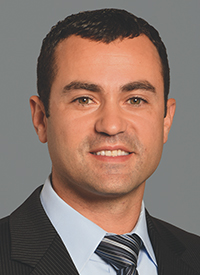
Portland’s multifamily sector has surged due to lack of supply in the face of new demand - by Joseph Porta
 Joseph Porta, CBRE | The Boulos Company
Joseph Porta, CBRE | The Boulos CompanyThe city of Portland has a total renter occupied housing stock of 16,800 units, per a survey commissioned by City Hall in 2014. Local capital markets tend to follow national trend lines, inelastically but consistently; yet downtown Portland’s multifamily sector has surged over the last three years with a higher beta, due primarily to one factor: lack of supply in the face of new demand. The private sector is robustly solving for this shortage, with nearly 700 new rental units being added to the downtown market alone in 2016 and 2017. This represents a four percent increase in the total inventory of renter occupied multifamily properties citywide, which is a staggering ratio when compared to some of the nation’s top multifamily markets.
Nationally, we saw vacancy rates creep up 10 basis points from Q2 of 2015 to 4.4% year over year. This is a relatively small uptick considering the national marketplace absorbed a net quantity of 202,000 new units in the trailing 12 months. The second quarter year over year rent appreciation was down from 5.3% in 2015 to 3.3% in 2016, which is still above the historical average annual increase of 2.4%. A sample from a handful of Portland’s largest landlords reported an increase in vacancy to four percent up from roughly three percent a year ago, with overall rents flattening and projected to stay at roughly the same levels over the next 12 months. This is a sign of two things: 1) Portland is sustaining occupancy rates and rents on par with national averages despite absorbing an immense quantity of new inventory relative to the existing housing stock; 2) competition is adding choices to the marketplace and halting some of the rate increases experienced in 2014 and 2015 when Portland’s downtown rental increases kept pace with the 5% national average.
 Historical U.S. vacancy rates and change
Historical U.S. vacancy rates and changePortland’s aging and antiquated housing stock has benefitted greatly from economic and social trends which are extending the length of time individuals and families are willing to rent instead of own. Urban living continues to be the preferred choice of Millennials and is increasing in popularity among baby boomers. For the first time in Portland’s modern history, there is demand for a class A renter occupied product to service middle and upper middle class demographics. That inventory simply did not exist in any meaningful scale in previous years, with 39% of the state’s 1.33 million population living in suburban communities within a radius of 25 miles to downtown.
These demand trends should continue and we expect supply to follow and expand to all apartment types. Investment capital looking for long-term, stable returns is also targeting renters looking for smaller, more affordable product. One example of this locally is in the Schlotterbeck and Foss redevelopment on Preble St., which is delivering 57 efficiency and one-bedroom units with higher-end finishes in apartments as small as 250 s/f, and rent options starting around $1,000 per month. In addition to what is happening at the top of the rental and condo markets, the renovation of hundreds of existing rental properties are being renovated not just to capture higher rents, but oftentimes to defend against long-term erosion in rents as part of an asset management strategy utilizing historically low interest rates. This will provide more choice to the consumer and has already instigated competition amongst landlords.
 Homeownership vs. Renter rates
Homeownership vs. Renter ratesDowntown Portland’s growth of 700 units of net new supply over the next two years in multifamily inventory is emulating that of considerably larger markets. In fact, that growth outpaces two cities on the list of the U.S.’s top 45 multifamily markets. Providence and Memphis have inventory levels of 99,142 and 85,139 units respectively and added 183 and 699 new units since Q2 of 2015. Portland’s downtown showed durability throughout the last recession and strength since then with cap rates dropping across all asset classes, and market values steadily rising to all-time highs. With interest rates on the rise, look for cautious but continued steady growth in downtown urban infill, as supply continues reacting to a permanent shift in the increasing willingness to rent across all income demographics.
Joseph Porta, SIOR, is partner of CBRE | The Boulos Company, Portland, ME.